Differentiated instruction strategies are teaching methods that cater to diverse learners in a classroom. Its focus is to provide differentiated teaching that meets every student’s learning needs, preferences, and interests. It is an approach to education that ensures every student receives a quality education.
It’s important to remember that not all students are the same in education. Creating an inclusive and effective classroom learning environment requires acknowledging students’ varying backgrounds, abilities, and learning speeds. Teachers can achieve this by implementing differentiated instruction strategies that allow them to customize their teaching methods to meet the diverse needs of each student. This personalized approach promotes academic growth, maximizes student engagement, and instills a love for learning. Customized instruction can help teachers increase student engagement, foster intellectual development, and foster learning enthusiasm. This article will cover the importance of differentiated instruction strategies and explore various approaches and examples in different educational settings.
What are Differentiated Instruction Strategies?
Differentiated instruction strategies are various teaching approaches teachers use to accommodate different learning styles and preferences. They are tailored to meet the complexity of students’ abilities, interests, and prior knowledge. In essence, these strategies enable students to reach their maximum potential while allowing them to learn in the best possible way.
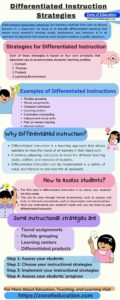
Differentiated Instruction Strategies
Strategies for Differentiated Instruction
Each of these strategies is based on four core principles that educators use to accommodate students’ learning profiles:
- Content
- Process
- Product
- Learning Environment.
To Watch Differentiated Learning, Click Here
To meet the diverse learning needs of students, information is provided in different formats and levels of complexity, along with alternative resources. Adapting the instructional process is necessary for this.
The instruction process should be adapted by utilizing different instructional methods, providing varying levels of scaffolding or support, and offering student choices. Students can demonstrate their understanding through presentations, projects, or written assignments by differentiating product expectations. To optimize student engagement, students need to be able to engage in flexible learning environments by organizing the classroom layout, establishing routines, and creating collaborative opportunities.
The following are the strategies teachers use for differentiated instruction:
- Flexible grouping
- Tiered assignments
- Compact curriculum
- Learning centers
- Curriculum compacting
- Independent study units
- Peer or mentor tutoring
- Interest centers
Examples of Differentiated Instruction
- Students are given different reading materials based on their reading level.
- Small groups are formed and assigned activities depending on their ability level.
- Students are given options for completing the assignment, i.e., typing or writing.
- The teacher provides feedback that is tailored to the student’s needs.
Different Types of Differentiated Instruction in a Classroom
It is possible to differentiate instruction in several ways within a classroom setting. One example of tiered instruction is providing students with different levels of content and tasks based on their readiness. This way, students are challenged appropriately and can progress at their own pace. Students can also be assigned to small groups based on their learning needs using flexible grouping. As a result, teachers can provide targeted instruction, peer collaboration, and individualized student support.
Furthermore, teachers can implement learning contracts that involve students in setting goals, selecting activities, and establishing evaluation criteria. As a result, students can take charge of their learning. By embracing Through differentiated instruction, educators can create a dynamic and inclusive classroom environment that caters to students’ individual needs.
Different types of differentiated instruction include curriculum differentiation, product differentiation, and process differentiation.
Differentiated Instruction Strategies for All Students
In addition to accommodating diverse learners in the classroom, differentiated instruction can benefit all students. Consequently, students feel empowered and intrinsically motivated and gain a deeper understanding of concepts when students engage with content in ways that resonate with their learning pathways. In addition, differentiated instruction fosters collaboration and empathy among students and encourages collaboration and compassion. Educators can create an inclusive and equitable learning environment by using differentiated instruction strategies.
The following are the generalized differentiated instruction strategies that teachers can use for all students:
- Explaining the lesson objectives clearly
- Using a variety of teaching methods
- Providing feedback
- Setting challenging goals
Differentiated Instruction Strategies PDF
Various resources are available to support educators in implementing differentiated instruction strategies, including PDF guides and manuals. These documents provide comprehensive overviews of differentiated instruction, examples of systems, and practical tips for educators can access these PDF resources to gain a deeper understanding of differentiated instruction and learn new approaches to personalizing instruction. Furthermore, these resources often offer insights into best practices and research-based strategies, allowing educators to make informed decisions about their instructional practices.
This downloadable document provides a detailed list of differentiated instruction strategies teachers can use to improve their teaching.
Differentiated Instruction Strategies for Math
Teachers can use differentiated instruction for math to cater to students. Strategies such as flexible grouping and tiered activities have proven effective. With its unique conceptual understanding and procedural skills, mathematics can greatly benefit from differentiated instruction.
Educators can differentiate math content by offering various entry points, demonstrating real-world applications, or providing alternative explanations and representations. Through scaffolding or peer tutoring, manipulatives can be utilized for hands-on learning, or technology can be integrated to enhance engagement to differentiate instruction. Differentiation can be achieved in math by offering different problem-solving tasks, allowing creative solutions, or presenting extension activities for advanced learners. Educators can foster a deeper understanding and appreciation of mathematics among their students by incorporating these strategies.
Differentiated Instruction Strategies for Gifted Students
Gifted students, characterized by their advanced cognitive abilities and exceptional talents, also benefit from differentiated instruction strategies.
Educators can offer these students opportunities for independent research projects, extension activities, or mentorships with experts in their interest; by allowing gifted students to delve deeper into topics and explore complex ideas, their intellectual curiosity is nurtured and their potential maximized. Additionally, flexible grouping strategies can create peer learning environments where gifted students collaborate and challenge one another. These strategies ensure talented students are appropriately challenged, engaged, and supported in their educational journey. Gifted students are those with above-average intelligence and can learn more complex things. Teachers can use compacted curricula, independent study units, and mentor tutoring to challenge and help them reach their potential.
Differentiated Instruction Strategies for Kindergarten
Kindergarten students are young and need playful learning techniques that stimulate their creativity. Strategies used include learning centers, peer learning, and active play activities. Providing differentiated instruction in kindergarten classrooms is crucial to establishing a solid foundation for academic success in the future.
Educators can differentiate instruction by integrating play-based activities, facilitating hands-on exploration, and providing multisensory learning experiences. Teachers must adapt instruction to meet students’ readiness levels, offer multiple concept entry points, and incorporate visual and auditory supports to determine content. They can also adjust their learning environment by creating centers or stations that address different learning styles and interests. Educators foster young learners’ love of learning, boost holistic development, and promote lifelong learning by implementing these strategies.
Differentiated Instruction Strategies for High School Students
High school students need activities that challenge them and help them apply concepts learned in life. Strategies used include independent study units, tiered assignments, and interest-based projects. It is even more crucial to differentiate instruction in high school as students’ interests, abilities, and career aspirations change. Educators can differentiate instruction by providing reading materials, assigning project-based tasks, or integrating technology. A flexible grouping strategy allows students to work with peers with similar interests or goals.
Education can promote autonomy and empower students to take ownership of their learning by giving them choices in assessments and allowing them to voice their opinions. In addition, teachers can use real-world applications to enhance relevance and cultivate critical thinking skills, enhancing student engagement, academic achievement, and postsecondary readiness.
Differentiated Instruction Strategies for Special Education Students
Special education students have different learning needs, and teachers can use differentiated instruction to create personalized education. Strategies used include a compacted curriculum, peer tutoring, and flexible grouping.
Individual support and access to the curriculum are possible with differentiated instruction.
Educators can do so by creating visual supports, modifying learning materials, or using assistive technology to meet the needs of different students.
Adapting the teaching process involves breaking down tasks into smaller steps, checking for understanding frequently with special needs, ensuring they receive In differentiate instruction; and educators can modify learning materials to suit students’ learning styles, provide visual aids, or utilize assistive technology to meet students’ needs. In addition to breaking tasks into smaller steps, providing frequent checks for understanding, and providing additional support through co-teaching or peer tutoring, the instruction process can be adapted.
Students can demonstrate their understanding in various ways, such as through verbal responses, visuals, or hands-on activities. These strategies enable special education students to access and engage with the curriculum effectively, promoting their overall academic growth and self-confidence.
Differentiated Instruction Strategies, Multiple Intelligences
Differentiated Teaching strategies based on Howard Gardner’s theory of multiple intelligences allow educators to teach based on the strengths and preferences of students.
According to Howard Gardner’s theory of multiple intelligences, individuals possess different strengths and abilities across various intelligences, including linguistic, logical-mathematical, spatial, bodily-kinesthetic, musical, interpersonal, intrapersonal, and naturalistic. Incorporating differentiated instruction strategies, Students’ unique strengths and learning preferences can be tapped into when educators align with this intelligence.
In contrast, linguistic learners will benefit from reading and writing activities, while bodily-kinesthetic learners will benefit from hands-on activities. Incorporating these strategies into the classroom creates an environment that celebrates and nurtures students’ diverse intelligence while creating a balanced and inclusive learning environment.
List of Differentiated Instruction Strategies
- Flexible grouping
- Tiered assignments
- Compact curriculum
- Learning centers
- Peer or mentor tutoring
- Interest centers
- Curriculum compacting
- Independent study units
Differentiated instruction can be implemented in a variety of ways. Here are a few suggestions educators may consider:
- Tiered instruction: Teaching content or tasks at different levels based on the student’s readiness.
- Flexible grouping: Grouping students accordingly to their learning styles.
- Learning contracts: Setting goals, activities, and evaluation criteria collaboratively with students.
- Choice boards: Offering a menu of options for students to choose from when demonstrating their understanding.
- Anchor activities: Providing ongoing activities that students can engage in when they complete assigned tasks.
- Graphic organizers: Utilizing visual tools to support understanding and organization of information.
- Learning centers: Creating stations or areas in the classroom that focus on different skills or topics.
- Scaffolding: Providing structured support and guidance as students work towards independent mastery.
- Peer tutoring: Pairing students to support and learn from one another.
- Varied assessments: Offering multiple ways for students to demonstrate their understanding, such as presentations, written assignments, or projects.
Importance of Differentiated Instruction Strategies
Differentiated instruction is important for students since it recognizes diverse learning styles. Students receive equal and quality education on what they can handle, and it increases student engagement, motivation, and learning outcomes.
Educators must implement diverse instructional strategies to create an inclusive and effective learning environment. Students have unique needs, abilities, and interests, and it’s essential to acknowledge and accommodate these differences to promote academic growth. Personalized instruction allows students to develop a deeper understanding of concepts, build confidence, and enhance critical thinking and problem-solving skills.
With differentiated instruction, classrooms can foster a positive atmosphere that values diversity, encourages collaboration, and promotes learning. Prioritizing differentiated instruction empowers students to reach their full potential and creates a sense of community in the classroom. This approach also allows for effective learning and teamwork among students. Using differentiated instruction, teachers can create a supportive environment promoting individual growth.
Research-Based Differentiated Instruction Strategies
Research-based strategies include technology, cooperative learning, and problem-based learning. Research shows differentiated instruction has been offered to improve student achievement, engagement, and attitudes toward understanding. Research has demonstrated that effective teaching strategies are one of the driving forces behind the evolution of education. To integrate research-based differentiated instruction strategies into teaching, educators should keep up with current literature, attend professional development workshops, and collaborate with colleagues to share best practices.
Differentiated instruction strategies based on research are a great way for educators to ensure that their differentiated instruction strategies are evidence-based and aligned with the latest educational findings. Educators should also seek student feedback to ensure their strategies are effective in the classroom. Additionally, educators should be willing to adjust instructional strategies in response to student feedback and data to ensure all students can learn.
Differentiated Reading Instruction Strategies for Primary Grades
Strategies that can be used for differentiated reading instruction in primary grades include book clubs, literature circles, and centers.
The primary grades provide a critical foundation for academic success. Differentiated reading instruction strategies cater to young students’ varied needs and abilities. Educators can differentiate reading instruction by providing leveled reading materials, implementing guided reading groups, and implementing targeted phonics instruction.
Integrating multisensory approaches, such as incorporating movement, music, and visuals, can also strengthen engagement and enhance reading proficiency. By employing these strategies, educators lay a solid literacy foundation, promote reading fluency, and foster a love for reading among young learners.
Differentiated Instruction Strategies in Teaching
Differentiated instruction strategies in teaching are a way of catering to heterogeneous classes. Teachers use various teaching styles to ensure every student receives a quality education. Effective teaching practices are based on differentiated instructional strategies. By incorporating these strategies, educators can cater to the unique needs of their students, thereby increasing motivation, engagement, and academic achievement.
In differentiated instruction, teachers adapt instructional methods, materials, and assessments to meet the diverse learning profiles of students. This facilitates a student-centered environment, which promotes meaningful and personalized instruction. Differentiated instruction contributes to the creation of a dynamic and inclusive classroom environment where all students have the opportunity to succeed.
Differentiated Instruction Strategies for Teachers
As educators, they should understand that each student has different learning needs. Teachers should use the right teaching strategies to meet all students’ unique needs.
Implementing differentiated instruction strategies requires thoughtful planning, ongoing assessment, and flexibility. Teachers can begin by getting to know their students’ strengths, interests, and learning needs through pre-assessments and ongoing formative assessments.
This information guides the selection of appropriate instructional strategies and materials.
Teachers must be willing to adjust instructional strategies and materials to meet changing student needs.
Active engagement and frequent feedback also provide teachers with information to adjust instruction.
Teachers can also collaborate with colleagues to share ideas, resources, and best practices for differentiated instruction.
Reflecting on the effectiveness of implemented strategies and making adjustments based on student feedback and outcomes is crucial for continuous improvement. Educators can implement differentiated instruction strategies effectively by adopting a growth mindset and committing to professional development.
This collaboration and reflection process helps teachers stay current on instructional methods and better understand their students’ needs. It also allows them to adjust their teaching strategies and materials to meet the needs of each student in the classroom, which can lead to improved academic and social-emotional outcomes. Additionally, this process can foster community and collaboration among teachers, leading to increased job satisfaction and better overall morale.
Differentiated Instruction in Math
Math is a subject full of different students with different abilities. Teachers can use differentiated instruction to cater to their strengths. Examples include tiered assignments and independent study units.
Students’ diverse learning needs can often be accommodated by differentiated math instruction. Educators can differentiate math instruction by varying the complexity of tasks, providing multiple representations of concepts, and incorporating manipulatives and visual aids.
Students can work collaboratively with peers at similar skill levels through flexible grouping strategies, fostering peer support and learning. Students can also demonstrate their understanding in ways that align with their learning preferences when they choose problem-solving approaches and assessment methods.
Students develop deep conceptual understanding, mathematical reasoning, and problem-solving skills when educators implement these strategies.
History of Differentiated Instruction
In the early 20th century, progressive education inspired differentiated instruction, which has evolved. Influential educators such as John Dewey and Maria Montessori emphasized tailoring instruction to meet individual students’ needs.
However, during the 1970s that “differentiated instruction” gained prominence due to the work of educational scholars like Carol Ann Tomlinson. As a result, differentiated instruction has gained widespread recognition as an effective way of meeting the diverse needs of students in inclusive classrooms since then.
As educators and researchers explore new strategies and adapt them to the ever-changing educational landscape, differentiated instruction continues to evolve today.
Four Ways to Differentiate Instruction
In differentiated instruction, students’ learning needs are recognized and addressed in a classroom. By tailoring instruction to accommodate varying readiness levels, interests, and learning styles, educators can engage students more effectively and help them reach their full potential.
It involves tailoring instruction to accommodate a variety of readiness levels, interests, and learning styles. This article discusses four key ways to differentiate instruction: content, process, product, and learning environment.
Content
Providing different levels of complexity, additional resources, or alternative materials to address individual student readiness levels
Examples of differentiating activities:
- Graphic organizers: Provide visual organizers or diagrams to help students organize and understand information.
- Reading materials for different reading levels: Offer books, articles, or texts at varying levels of complexity to match students’ reading abilities and challenge them appropriately.
Process
Utilizing various instructional methods, incorporating technology, offering choices in learning activities, and adapting pacing to accommodate different learning styles and preferences.
- Small group instruction: Conduct small group sessions where students with similar learning needs can receive targeted education and support.
- Discovery learning activities: Engage students in hands-on, inquiry-based activities that allow them to explore and discover concepts independently.
Product
Allowing students to demonstrate their understanding through different means, such as presentations, projects, written assignments, or creative performances.
- Writing task choices: Provide students with options for demonstrating their understanding, such as writing an essay, creating a poster, or recording a video.
- Presentations: Allow students to present their learning in different formats, such as oral presentations, multimedia presentations, or dramatic performances.
Learning Environment
Creating a classroom environment fosters collaboration, offers flexible seating arrangements, and incorporates centers or stations to address diverse learning needs and interests.
- Use of music: Incorporate background music that matches the mood or theme of the lesson to enhance student engagement and focus.
- Flexible seating: Arrange the classroom with various seating options, such as standing desks, bean bags, or floor cushions, to accommodate different learning preferences and promote comfort.
Pros and Cons of Differentiated Instruction
Pros
- Personalized learning: Differentiated instruction recognizes and addresses individual student needs, fostering a more tailored and effective learning experience.
- Increased engagement: By offering choices, incorporating student interests, and providing varied instructional methods, differentiated instruction promotes student engagement and motivation.
- Inclusive environment: Differentiated instruction embraces diversity, ensuring that all students, regardless of their abilities or backgrounds, have access to meaningful and challenging learning experiences.
- Skill development: By differentiating instruction, educators can target specific skill areas, providing additional support or challenges as needed, leading to improved student outcomes.
- Students receive a personalized education.
- Students learn at a pace suitable for them
- Teachers cater to diverse learners
- Engagement and motivation are high
Cons
- Time and planning: Implementing differentiated instruction requires thoughtful planning, ongoing assessment, and allocating instructional time to address individual needs. This can be challenging, given the demands of a busy classroom.
- Classroom management: With different students engaged in various tasks and activities, managing the classroom and ensuring that all students receive appropriate attention and support can be demanding.
- Assessment complexity: Assessing and evaluating student progress and understanding in a differentiated classroom can be more complex due to the diverse range of tasks and products. Teachers must develop effective assessment strategies to measure learning accurately.
- Requires more work from teachers
- It may be challenging to create unique learning plans
- Requires flexibility
Despite the challenges, the benefits of differentiated instruction far outweigh the drawbacks. With careful planning, professional development, and ongoing reflection, educators can navigate the challenges and create a supportive and engaging learning environment that meets the diverse needs of their students.
FAQs
How does differentiated instruction benefit students?
Differentiated instruction benefits students by providing personalized learning experiences that cater to their unique needs and abilities. It promotes engagement, motivation, and academic growth, fosters a positive classroom climate, and develops critical thinking and problem-solving skills.
How can teachers differentiate instruction?
Teachers can differentiate instruction by varying the complexity of content, providing multiple entry points to concepts, offering choices in learning activities, utilizing flexible grouping strategies, and adapting assessments to align with students’ abilities and preferences.
Can differentiated instruction be implemented in all subject areas?
Yes, differentiated instruction can be implemented in all subject areas. By adjusting content, process, and product to meet individual student needs, educators can effectively differentiate instruction in any subject, including math, reading, science, social studies, and more.
Is differentiated instruction only for students with special needs?
Differentiated instruction benefits all students, not just those with special needs. Every student has unique strengths, interests, and learning styles. Educators can ensure students receive an inclusive and personalized learning experience by differentiating instruction.
In summary, differentiated instruction strategies provide a framework for addressing the diverse needs of students, promoting engagement, motivation, and academic growth. The differentiation of content, process, and product creates a learning environment that values student diversity and fosters a passion for learning when educators differentiate content, process, and product. Educators can enhance their ability to implement differentiated instruction effectively by pursuing ongoing professional development, collaboration, and research-based practices.
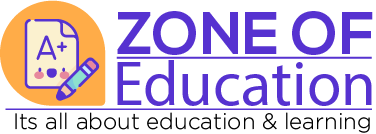
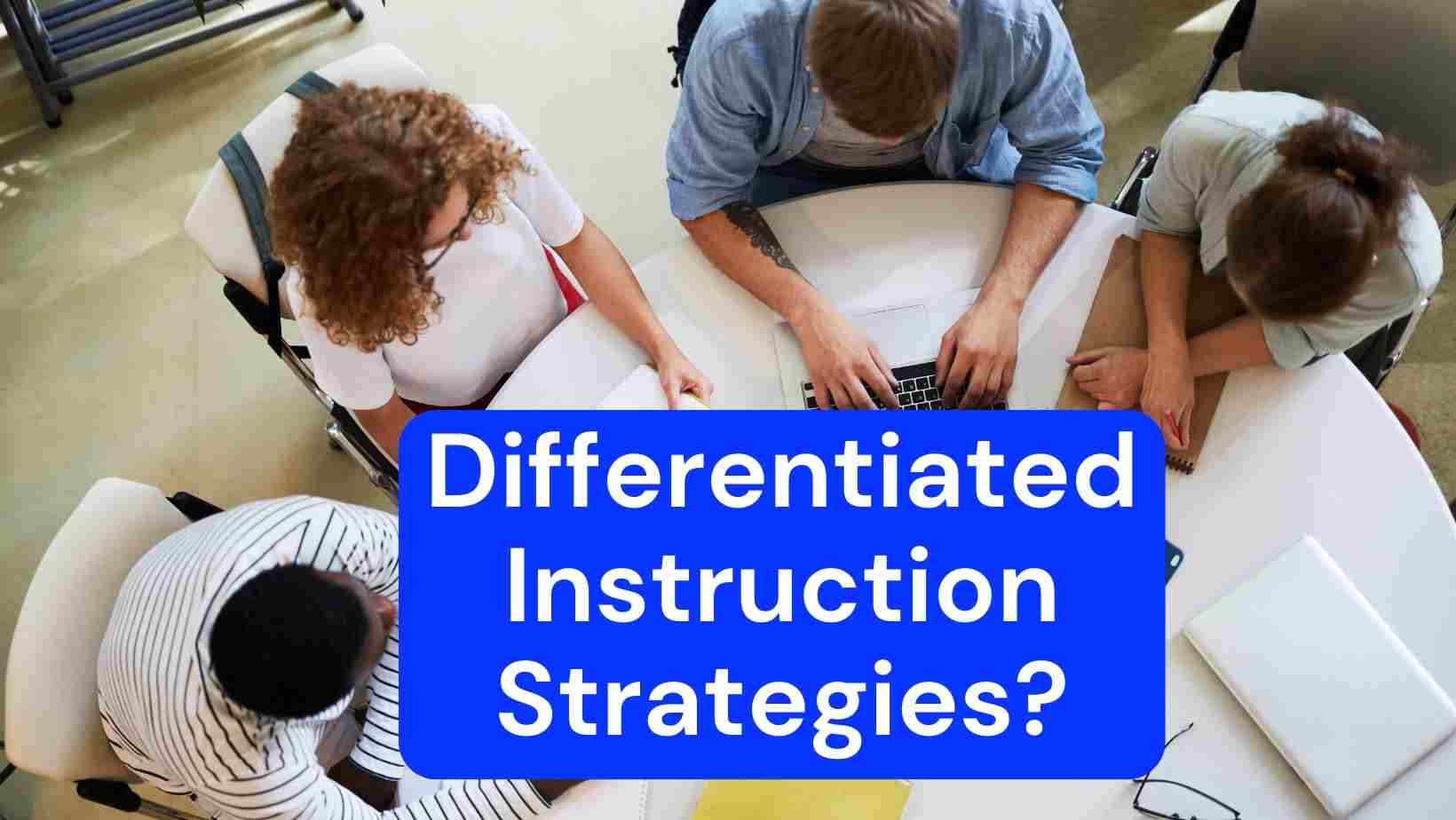

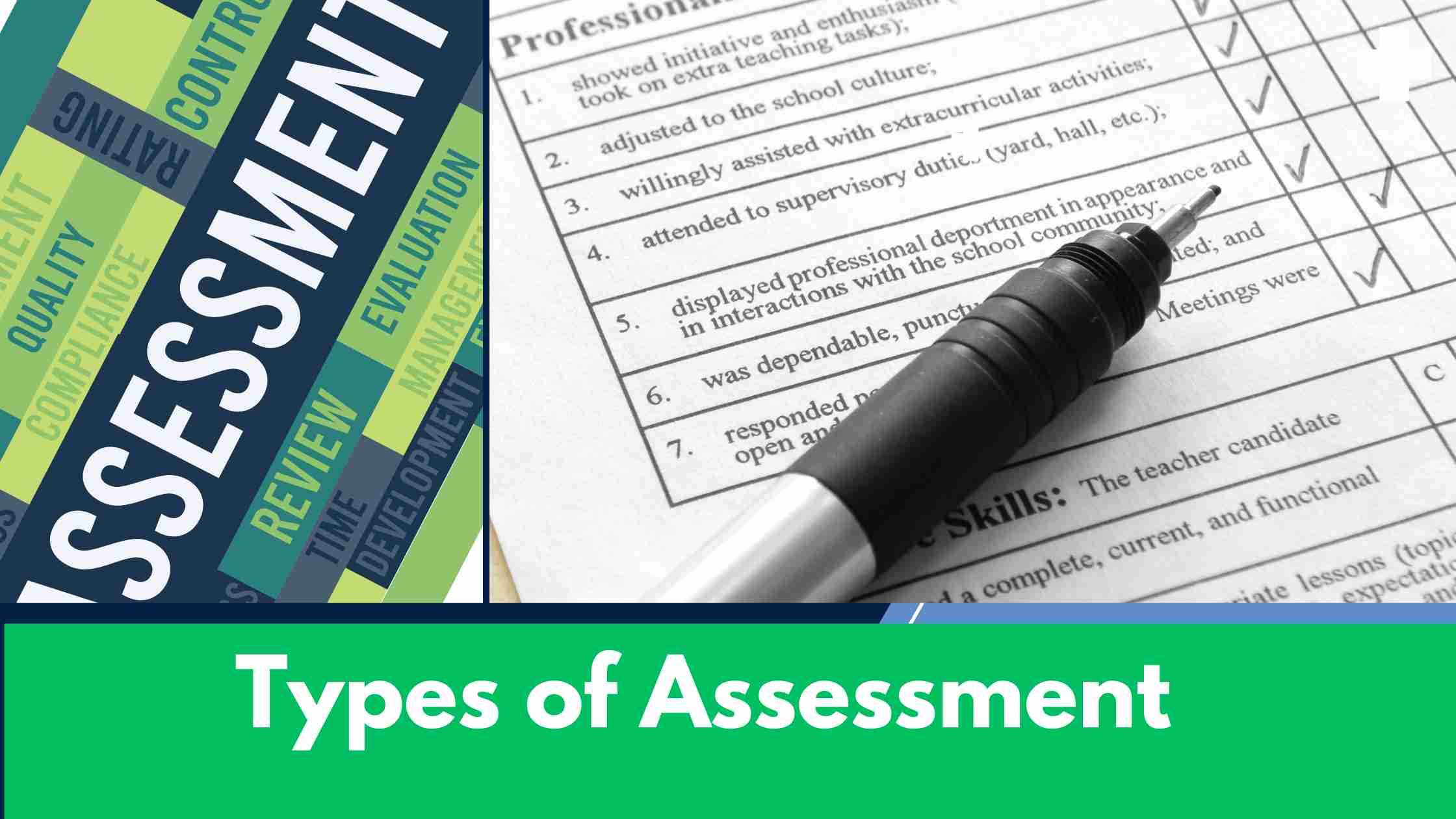
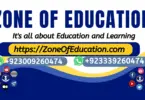
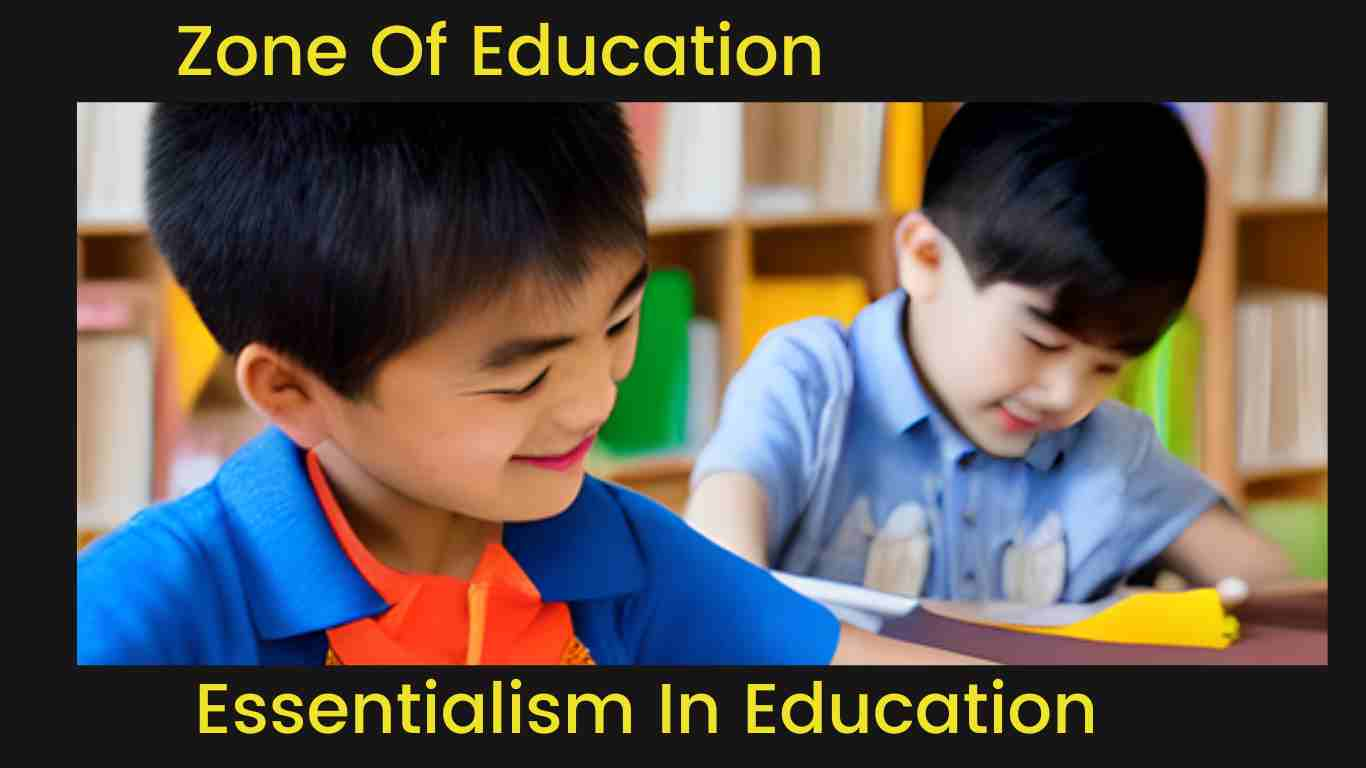
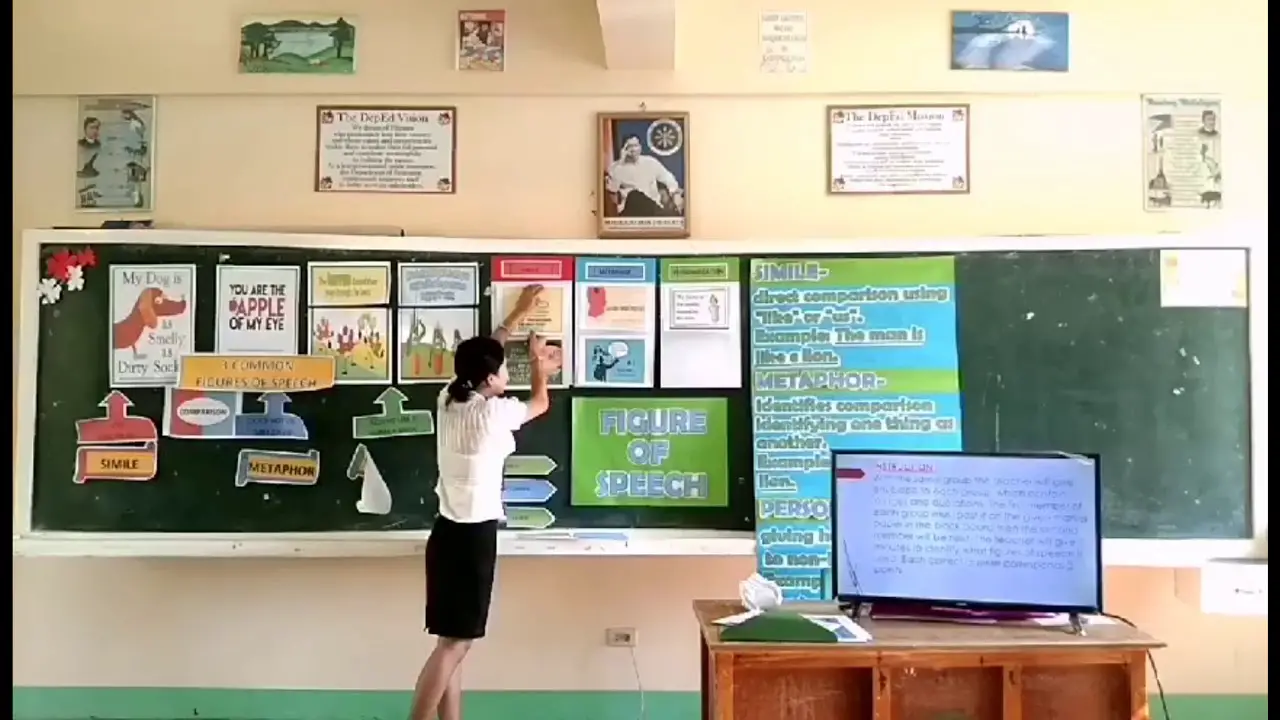
[…] Differentiate instruction by providing varying levels of support, scaffolding, and resources. Encourage peer collaboration, where advanced learners can assist their peers, fostering a sense of community and shared learning. […]
[…] One of the primary purposes of summative Assessment is to measure student achievement at the end of a learning period or course. By assessing students’ understanding of the entire curriculum, summative assessments enable educators to determine whether learning goals have been met. This information is essential for tracking individual and group progress, identifying assessment strengths and weaknesses, and making informed decisions about instructional strategies. […]
[…] and exploring ideas through questioning and dialogue. This article explores how the Socratic method enhances learning by fostering deeper understanding, encouraging active engagement, and developing essential skills […]
[…] conducive to attaining these aims. Understanding educational philosophy offers pupils a basis for personal development and lifelong learning. Educators and students must thus have a comprehensive knowledge of educational […]
[…] instructional strategy that emphasizes the growth of virtues like respect, responsibility, and integrity is character […]
[…] ideas and values that have existed since the beginning. It gives students a solid base for lifelong learning and personal growth. As a result, children learn how to think critically, interact with complex concepts and […]
[…] into their engagement, understanding, and overall well-being. This allows educators to tailor their instructional strategies, provide targeted support, and create a positive learning environment that fosters student success. […]
[…] students to identify their strengths and weaknesses and to improve their learning.Differentiating instruction: Differentiating instruction means tailoring the teaching to the needs of individual students. This […]
[…] benefits of peer assessment can include increased collaboration, improved communication, and enhanced learning. It also encourages students to take responsibility for their learning, as they can evaluate their […]
[…] By using these assessment tools, teachers can save time on grading and data collection and gain valuable insights into their students’ strengths and weaknesses. Moreover, these tools promote active student engagement and provide opportunities for personalized learning. […]
[…] Assessment provides feedback to learners and educators, enabling them to make informed choices and enhance learning experiences. Moreover, assessment is crucial in determining the effectiveness of educational […]
[…] instruction to meet the diverse needs of their students. Teachers can provide targeted support and differentiated instruction by understanding where each student stands in their learning journey. This personalized approach […]
[…] First and foremost, effective behavior management contributes to a learning environment conducive to academic achievement. When disruptive behavior is minimized and positive behavior is fostered, students are more likely to be focused, attentive, and engaged. A well-managed classroom provides a secure, predictable environment that supports and enhances learning. […]
[…] way to adjust instructional strategies is through differentiating instruction. This involves modifying the content, process, or product of learning to accommodate […]
[…] Naturalism Philosophy is a type of Educational philosophy that states that only natural laws and forces exist in the universe and drive the world in accordance. It also denies the existence of God and supernatural influence. Naturalism in education is based on the idea that children should learn and explore in a natural setting, rather than in a traditional classroom. This means that experiential learning and outdoor activities are prioritized over traditional lecture-based instruction. […]
[…] Personalized Learning: Modern philosophies such as Constructivism, Existentialism, and Pragmatism em…. This has led to the adoption of student-centered approaches in education, where learners are actively engaged in the learning process and encouraged to take ownership of their education. […]
[…] Formative Assessment: Continuously assess student progress and adjust instruction to ensure continued differentiation. […]
[…] differentiation: Utilize diverse instructional strategies to cater to individual learning styles and […]
[…] instruction also requires educators to be adaptable and willing to modify their instructional strategies to meet the requirements of individual […]
[…] further enhance the development of personalized learning goals and action plans, educators can provide students with resources and strategies to help them […]
[…] Personalized learning is an instruction strategy to meet the individual needs, interests, and learning styles of each student. Through adaptive technologies, differentiated instruction, and flexible pacing, educators provide personalized learning pathways that allow students to progress at their own pace and receive targeted support and feedback. […]
[…] from educational psychology, educators can make informed decisions about curriculum design, instructional strategies, and classroom interventions to meet the diverse needs of learners and promote academic […]
[…] scientists, adept at analyzing the influence of the school environment, classroom dynamics, and instructional strategies on students’ behavior and learning outcomes. By critically examining the interplay between environmental factors and student behavior, […]
[…] of our students’ individual strengths, weaknesses, and learning styles. This empowers us to personalize instruction, create effective interventions, and ultimately, foster a love of learning in every […]
[…] It addresses practical issues in education, such as student motivation, classroom management, instructional strategies, and educational interventions, which are central concerns of social […]